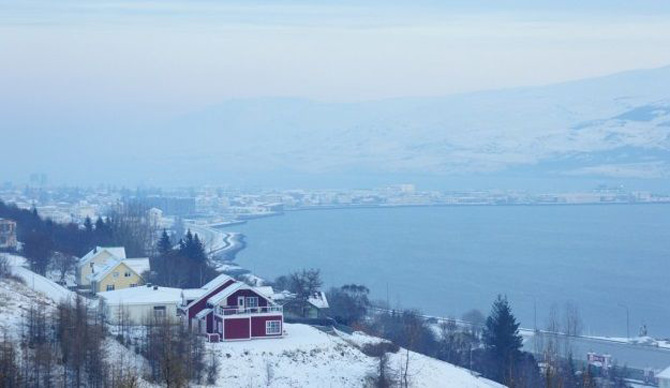Blue Haze
Nov 8, 2014

Our last look at Iceland's ongoing volcanism touched on matters of earthquakes, a collapsing caldera, magma, lava, and tectonic rifting. But we failed to discuss the issue that has come to preoccupy Icelanders in recent months: poison gas, which spreads across the island as a blue haze, threatening the health of people, livestock, crops, and vegetation.
The gas belches out of the lava as sulfur dioxide, SO2, which is the odor we sniff in minute amounts when we strike a match. Around the site of the eruption, in barren terrain near central Iceland's Bardarbunga volcanic complex, the sulfur dioxide is so intensely concentrated that a single breath could be fatal. Fortunately, no one lives nearby; researchers approaching the volcanic vent wear elaborate gas masks and stay in the vicinity for only a few minutes at a time.
In addition to being dangerously sulfurous, the air near the eruption is also extremely turbulent. Steam from the vent and heat gusts from the surface of the lava lift and disperse the SO2 quite quickly. Early in the eruption, huge pulses of steam pushed the gas so high into the atmosphere that it was entrained in the jet stream and carried in low but measureable concentrations across the sea to northern and western Europe.
Within a few days, however, as the volcanic vent opened fully, the lava spilled out less forcefully. Sulfur dioxide was no longer blasted into the upper atmosphere; instead, it has settled as a smoggy blue haze, rolling along the surface of Iceland. The haze is steered by winds; an east wind blows it into Reykjavik, as seen above, while winds from other points of the compass blow it to every nook and cranny of the island.
When the haze is bad, Icelanders are told to stay indoors, close their windows, and run their heat full blast. Measured concentrations are well above known hazard levels, and people with weak lungs or compromised immune systems face serious health risks. Even healthy people experience burning eyes and throats, headaches, fatigue, and various degrees of breathing difficulties. Those who have to stay outdoors try to keep nose and mouth covered and are warned to avoid heavy exertion.
But the symptoms are temporary; the wind changes, the blue haze disappears, and everybody feels better. Children are allowed back outside to play.
The haze is not pure sulfur dioxide. It's more insidious than that. The SO2 combines with water vapor in the volcanic steam and the general atmosphere to produce aerosols of sulfurous acid, H2SO3, one of the principal components of acid rain.
And that's not the worst of it. The H2SO3 reacts with oxygen in the air to create a much more corrosive, extremely dangerous compound: sulfuric acid, H2SO4.
People can protect themselves from the worst of all this, but animals and plants, of course, are entirely exposed. They will suffer long-term effects. Iceland's last high-sulfur volcanic eruption, known as Laki, killed three-quarters of the country's livestock in 1783 and led to massive crop failures. Thousands of people died of starvation.
The volume of lava and sulfur spewed forth by Laki, however, is believed to be about fifteen times the amount currently erupting from Bardarbunga–500,000 metric tons daily from Laki, as opposed to 35,000 tons daily from Bardarbunga.
The current sulfur emissions are roughly comparable to the amount already entering the air every day from all the smokestacks in Europe. Iceland is a tiny place to be dealing with as much poison in the air as the entire continent of Europe.
The eruption is now two and a half months old. There are no signs that it is winding down just yet; it could continue for many more months, or years.
For what it's worth, sulfur dioxide is not a greenhouse gas; in fact, it blocks sunlight and has an overall cooling effect. As winter darkness envelops Iceland now, there's less and less sunlight to be blocked; if the sulfur is still hanging around next spring, the chill of an Icelandic winter may persist even longer than usual.